10
Management Considerations for Recommended Topologies
This chapter provides key considerations for managing the Oracle Application Server recommended topologies.
It contains the following topics:
10.1 About the Recommended Topologies
Oracle Application Server is a flexible product that offers a variety of topology options. To assist users in designing a topology, Oracle developed a set of recommended topologies that support common development and deployment requirements. These recommended topologies are documented throughout the Oracle Application Server 10g documentation library as described in Table 10-1.
Table 10-1 Oracle Application Server 10g Documentation Guide to Recommended Topologies
This chapter provides key considerations for managing the following topologies:
10.2 General Development Topologies
This section provides management considerations for the following recommended general development topologies:
10.2.1 Java Developer Topology
This topology provides ease of development and deployment for Java developers. It is intended to run on low-end machines with Java IDE tools.
Key management considerations for the Java Developer Topology are:
- Use Application Server Control for:
- Starting and stopping components as needed
- Enabling/Disabling unused components so they do not consume system resources
- Setting or changing configuration parameters for OC4J, Oracle HTTP Server, and OracleAS Web Cache
- Deploying and configuring applications
- Managing J2EE application security
- Monitoring application and component performance and resource consumption in real-time
- Viewing and setting port numbers
- Viewing and searching log files
- Managing OracleAS Clusters
- Use Application Server Control or JDeveloper to deploy applications
- Command-line utilities are available for scripting and automation, or if you use standalone components
- Use Oracle-recommended backup and recovery strategies
Figure 10-1 illustrates the Java Developer Topology. Note that "O_Hx" in the figure denotes an Oracle home directory.
Figure 10-1 Java Developer Topology
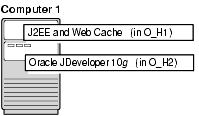
Text description of the illustration j2ee_standalone.gif
10.2.2 Portal and Wireless Topology
This topology provides an environment for OracleAS Portal and OracleAS Wireless developers. It includes an Infrastructure, which is required to deploy and test their applications. It is intended to run on medium-sized machines.
Key management considerations for the Portal and Wireless Developer Topology are:
- Use Application Server Control for:
- Starting and stopping components as needed
- Enabling/Disabling unused components so they do not consume system resources
- Setting or changing configuration parameters for OC4J, Oracle HTTP Server, and OracleAS Web Cache
- Deploying and configuring applications
- Managing application security
- Monitoring application and component performance and resource consumption in real-time
- Viewing and setting port numbers
- Viewing and searching log files
- Managing Infrastructure schemas
- Use Oracle DBA Studio for managing the Metadata Repository
- Command-line utilities are available for scripting and automation
- Use Oracle-recommended backup and recovery strategies
Figure 10-2 illustrates the Portal and Wireless Developer Topology. Note that "O_Hx" in the figure denotes an Oracle home directory.
Figure 10-2 Portal and Wireless Developer Topology
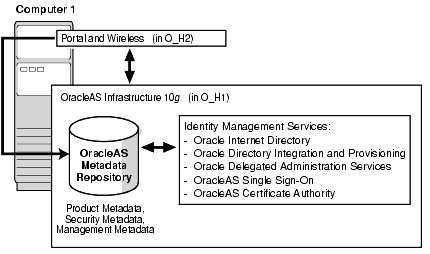
Text description of the illustration ascon038.gif
10.2.3 Forms, Reports, and Discoverer Developer Topology
OracleAS Forms Services, OracleAS Reports Services, and OracleAS Discoverer developers have similar application deployment requirements. They need an Infrastructure and Oracle Developer Suite to deploy and test their applications. This topology is intended to run on medium-sized machines
Key management considerations for the Forms, Reports, and Discoverer Developer Topology are:
- Use Application Server Control for:
- Starting and stopping components as needed
- Enabling/Disabling unused components so they do not consume system resources
- Setting or changing configuration parameters for OC4J, Oracle HTTP Server, and OracleAS Web Cache
- Deploying and configuring applications
- Managing application security
- Monitoring application and component performance and resource consumption in real-time
- Viewing and setting port numbers
- Viewing and searching log files
- Managing Infrastructure schemas
- Use Oracle DBA Studio for managing the Metadata Repository
- Command-line utilities are available for scripting and automation
- Use Oracle-recommended backup and recovery strategies
Figure 10-3 illustrates the Forms, Reports, and Discoverer Developer Topology. Note that "O_Hx" in the figure denotes an Oracle home directory.
Figure 10-3 Forms, Reports, and Discoverer Topology
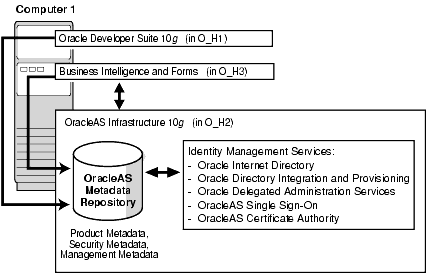
Text description of the illustration ascon039.gif
10.2.4 Integration Architects and Process Modelers Topology
Integration architects and process modelers require the OracleAS ProcessConnect middle-tier installation. They need appropriate adapters and an Infrastructure to deploy and test their integration applications. This topology is intended to run on medium-sized machines.
Key management considerations for Integration Architects and Process Modelers Topology are:
- Use Application Server Control for:
- Starting and stopping components as needed
- Enabling/Disabling unused components so they do not consume system resources
- Setting or changing configuration parameters for OC4J, Oracle HTTP Server, and OracleAS Web Cache
- Deploying and configuring applications
- Managing application security
- Monitoring application and component performance and resource consumption in real-time
- Viewing and setting port numbers
- Viewing and searching log files
- Managing Infrastructure schemas
- Use Oracle DBA Studio for managing the Metadata Repository
- Command-line utilities are available for scripting and automation
- Use Oracle-recommended backup and recovery strategies
Figure 10-4 illustrates the Integration Architect and Process Modeler Topology. Note that "O_Hx" in the figure denotes an Oracle home directory.
Figure 10-4 Integration Architect and Process Modeler Topology

Text description of the illustration ascon040.gif
10.3 General Deployment Topologies
This section provides management considerations for the following recommended general deployment topologies:
10.3.1 Enterprise Data Center Topologies
Enterprise Data Center topologies can be used by multiple departments sharing the same data center. There are two Enterprise Data Center topologies:
Key management considerations for Enterprise Data Center topologies are:
- Use Application Server Control for:
- Starting and stopping components as needed
- Enabling/Disabling unused components so they do not consume system resources
- Setting or changing configuration parameters for OC4J, Oracle HTTP Server, and OracleAS Web Cache
- Deploying and configuring applications
- Managing application security
- Monitoring application and component performance and resource consumption in real-time
- Viewing and setting port numbers
- Viewing and searching log files
- Managing Infrastructure schemas
- Use Oracle DBA Studio for managing the Metadata Repository
- Command-line utilities are available for scripting and automation
- Use Oracle-recommended backup and recovery strategies
Enterprise Data Center Topology for Java Applications
This topology assumes that you want to create new databases for Product, Management, and Security services. If you choose to use an existing database, the product metadata will inherit the high availability solution already deployed for that database.
Figure 10-5 illustrates the Enterprise Data Center Topology for Java Applications.
Figure 10-5 Enterprise Data Center Topology for Java Applications
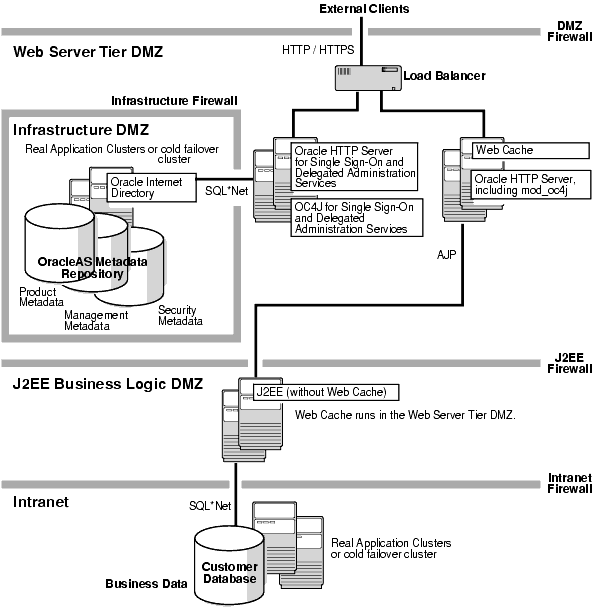
Text description of the illustration ascon047java.gif
Enterprise Data Center Topology for Portal, Wireless, Business Intelligence, and Forms Applications
This topology assumes that you want to create new databases for Product, Management, and Security services. If you choose to use an existing database, the product metadata will inherit the high availability solution already deployed for that database.
Figure 10-6 illustrates the Enterprise Data Center Topology for Portal, Wireless, Business Intelligence, and Forms Applications.
Figure 10-6 Enterprise Data Center Topology for Portal, Wireless, Business Intelligence, and Forms
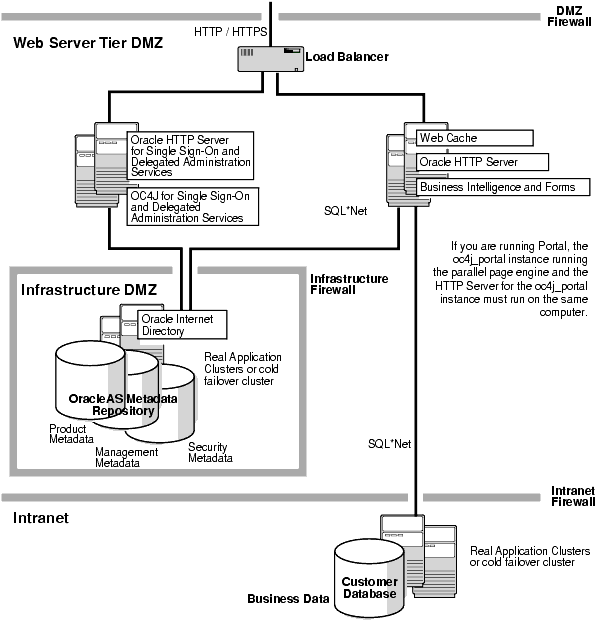
Text description of the illustration ascon047pwbi.gif
10.3.2 Departmental Topology
The Departmental Topology can be used by departments hosting their applications. This topology consists of a subset of considerations and requirements from the Enterprise Data Center topologies.
Key management considerations for using the Departmental Topology are:
- Use Application Server Control for:
- Starting and stopping components as needed
- Enabling/Disabling unused components so they do not consume system resources
- Setting or changing configuration parameters for OC4J, Oracle HTTP Server, and OracleAS Web Cache
- Deploying and configuring applications
- Managing application security
- Monitoring application and component performance and resource consumption in real-time
- Viewing and setting port numbers
- Viewing and searching log files
- Managing Infrastructure schemas
- Use Oracle DBA Studio for managing the Metadata Repository
- Command-line utilities are available for scripting and automation
- Use Oracle-recommended backup and recovery strategies
Figure 10-7 illustrates the Departmental Topology.
Figure 10-7 Departmental Topology
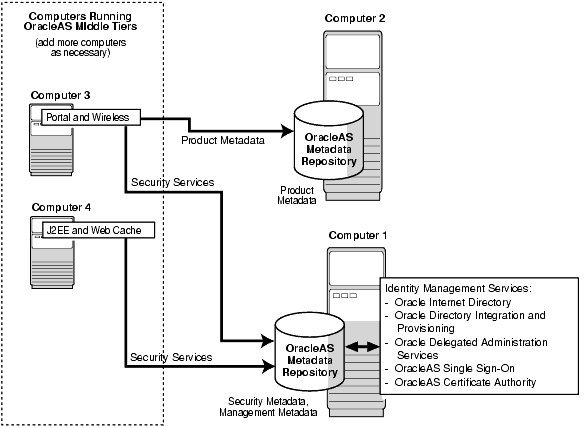
Text description of the illustration ascon041.gif
10.3.3 Development Life Cycle Support Topology
The Development Life Cycle Support Topology provides a seamless environment for moving applications from the test environment to the staging environment, and from there to the production environment.
The Development Life Cycle Support Topology is a combination of other topologies which support moving applications from test to stage to production environments.
- Test environment: Application developers test their applications in their own environments. Examples of testing environments:
- Stage environment: QA personnel test all applications before deploying them to the production environment. In this environment, you can use the Departmental Topology. This topology in a stage environment runs applications from all departments, not just from a single department.
- Production environment: Applications are ready for use by both internal and external users. See Enterprise Data Center Topologies.
Key management considerations for the Development Life Cycle Support Topology are:







